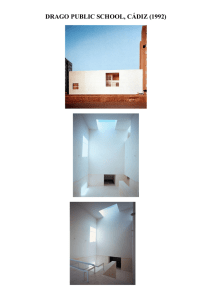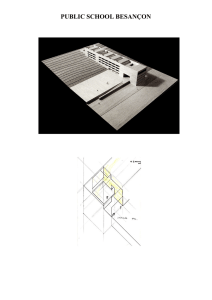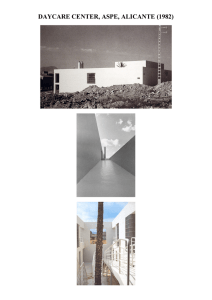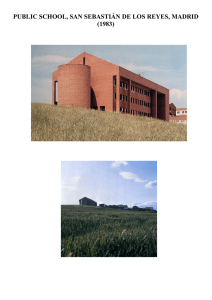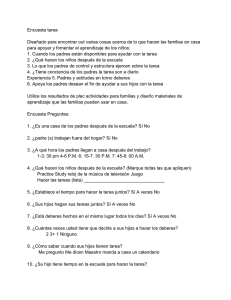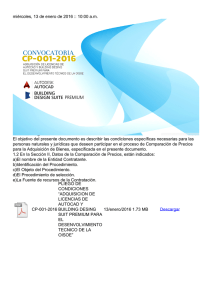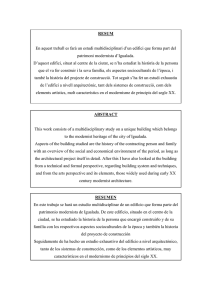edificios públicos public buildings
Anuncio
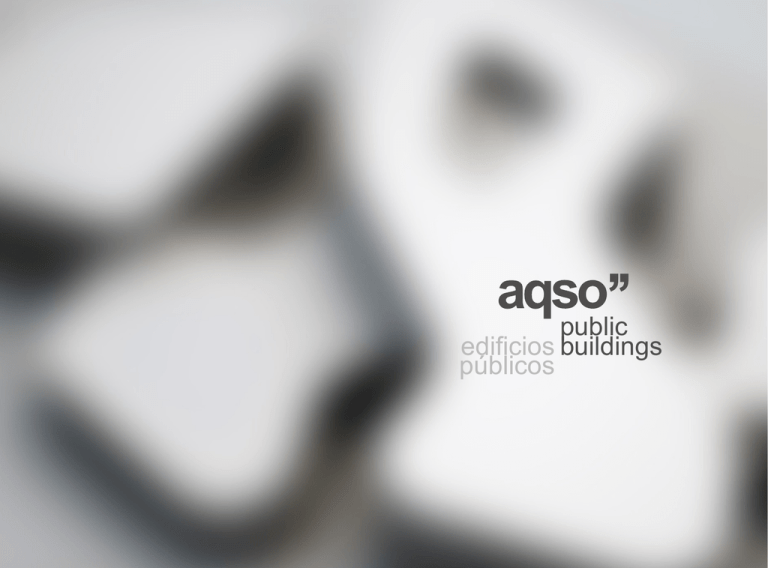
public edificios buildings públicos public edificios buildings públicos AQSO arquitectos office es un estudio multidisciplinar integrado por un colectivo internacional de profesionales dedicados a la arquitectura contemporánea, el diseño, el urbanismo y la investigación cultural. AQSO arquitectos office is a multidisciplinary studio composed of an international group of professionals dedicated to contemporary architecture, design, urban planning and cultural research. Edificios de uso público Fábrica en re-visión 8 Restauración S. Mª Atienza 16 Mercado del ocho 26 Fundación Xu Beihong 38 Ciudad de la música 46 Auditorio sin doblez 54 Pabellón Wavescape 64 Galería Boilerhouse 74 Museo cúbico fractal 84 Casa de las artes 92 Public buildings 8 Factory under re-view 16 Atienza music hall 26 Market eight 38 Xu Beihong foundation 46 Performing arts complex 54 Folded auditorium 64 Wavescape pavillion 74 Boilerhouse studios 84 Cubic fractal museum 92 House of arts 6 7 Public buildings Edificios de uso público Las dotaciones públicas engloban un variado conjunto de tipologías que constituyen el equipamiento para la colectividad. Son lugares de encuentro e identificación social, cualifican el lugar y su contexto e incluso pueden servir de catalizadores urbanos. Son edificios que combinan programas de necesidades complejos y versátiles con una imagen icónica y reconocible. Public facilities encompasses a wide range of typologies considered as communal spaces. They are places for encounters and social identity, qualifying a certain location and eventually becoming urban agents of change. They combine complex and versatile requirements with an iconic and recognizable image. 8 Factory under re-view Industrial museum in Liuzhou Fábrica en re-visión Museo de la industria en Liuzhou Situado en una antigua fábrica, el museo combina la vieja infraestructura con nuevos elementos contemporáneos. Un recorrido elevado conecta los edificios mientras la cubierta se convierte en la culminación de la exposición: la vista del paisaje ondulado de Liuzhou, una ciudad transformada por la industria. Lugar: Liuzhou, China Superficie útil: 62000 m2 Located in an old factory, the museum combines the existing structure with contemporary elements. An elevated path connects the buildings and a visit to the museum culminates with impressive views from a new roof terrace from which the undulating landscape of Liuzhou, a city strongly transformed by industry, can be contemplated. Location: Liuzhou, China GFA: 62000 sqm 9 10 La ciudad de Liuzhou está situada en el sur de China, en un fértil valle a orillas del río Liu. Su historia ha estado marcada por un proceso de desarrollo continuo. Su primera actividad estaba unida a la explotación de los recursos, principalmente la madera y el algodón, y hoy se ha convertido en el motor de la provincia de Guangxi, constituyendo un eje principal dentro del sector de la maquinaria, la metalurgia, la automoción y la industria química. Tras el despegue económico de la zona y la expansión de la ciudad, la prioridad ahora es la regeneración urbana y la consolidación de los espacios industriales como legado de su historia. El espacio museístico propuesto por el gobierno local tiene esta finalidad, y pretende precisamente ocupar una de las antiguas factorías situadas a orillas del río. Su situación es estratégica no sólo por estar próxima a una de las arterias principales de la urbe, sino también por tratarse de un enclave de alto valor paisajístico que debe cualificarse con la reconversión de la vieja estructura. La propuesta para el museo de la industria parte del análisis de cada uno de los edificios existentes, la catalogación de los elementos a conservar y la elaboración de un discurso expositivo que los relacione entre sí y con el resto de la parcela, que pasará a convertirse en un parque urbano. Los tres edificios principales se transformarán en contenedores de las partes principales del programa: la exposición permanente, un espacio para exposiciones temporales y los servicios administración y ocio. Esta metamorfosis pretende mantener su identidad original, convirtiéndolos en volúmenes neutros cuyos huecos de fachada ciegos se homogenizan con el mismo material. En contraste con el tratamiento sobrio de lo existente, se añaden al conjunto nuevos elementos contemporáneos con un lenguaje atrevido y rotundo. Formas angulosas de acero constituyen una estructura ligera que se despliega con decisión y conecta cada uno de los espacios, abrazando los tres volúmenes y ofreciendo una imagen unificadora del conjunto. Se trata de varias pasarelas elevadas que comunican los edificios para apoderarse de su cubierta con una relevancia especial: por un lado se convierte en la culminación de la exposición, pasando a ser una terraza multifuncional desde la que disfrutar del paisaje, y por otro su forma invertida permite introducir una luz cenital y neutra a los espacios interiores. El volumen principal, antiguamente utilizado para maquinaria, se perfora en su interior para albergar un atrio central en torno al cual se distribuye tanto la circulación de visitantes como las diversas salas de exposición. Si la antigua parcela industrial era un espacio cerrado con accesos limitados, el nuevo museo se abre a la ciudad constituyendo un pulmón verde. Los elementos del paisaje se utilizan para marcar la traza de los edificios desaparecidos y los espacios entre los nuevos volúmenes se articulan con plazas de carácter urbano. Se pretende que el museo, lejos de constituir una mera colección de piezas en exposición, se entienda como un elemento que explorar en relación con el paisaje. La extraordinaria vista de Liuzhou, su serpenteante río entre montañas onduladas y las edificaciones e infraestructuras, que pueblan el valle, constituyen un dialogo necesario para entender su historia. 11 12 The city of Liuzhou is located in southern China, in a fertile valley on the banks of the river Liu. Its history has been influenced by continuous development. Historically, this development was linked to the exploitation of resources, mainly wood and cotton, which today is the driving force of the Guangxi province. The region has become a center of machinery production, metallurgy and the automobile and chemical industries. After the economic boom of the area and the expansion of the city, the priority now is to carry out an urban regeneration process and to consolidate the old industrial areas as a legacy of the city’s history. The museum proposed by the local government, reflects this purpose and has been specifically designed to occupy one of the old factories located on the banks of the River. This spot is strategic, not only for being close to one of the main arteries of the city, but also because the landscape surrounding the building has a high value to be protected along with the conversion of the old structure. The proposal for the industrial museum is based on an analysis of the existing buildings, the cataloguing of the elements to be preserved, and the preparation of a new discourse incorporating also an urban park in the area of the plot. The three main buildings will be transformed into the principal parts of the program: a permanent exhibition, a temporary exhibition and administrative and leisure adjoining services. This metamorphosis intends to maintain the factory’s identity, converting them into neutral volumes whose façade is composed by simple openings homogenized with a single material. In contrast to the sober treatment of the existing elements, new contemporary elements are added with an intrepid and unequivocal sense. Steel angular shapes become a lightweight structure, unfolding and connecting different spaces, embracing the three volumes and providing a unifying image. Several elevated walkways connect the buildings ending up on the roof with a special relevance, which on one hand is the culmination of the exhibition, a multifunctional terrace from which to contemplate the undulating landscape, and on the other its reverse shape allows a neutral light to come through the interior spaces. The main volume, used for machinery in the old days, is drilled on the interior to house a central atrium around which visitors can move and view the showrooms. This high-rise space becomes the heart of the museum and is the reference point and the entry point, which articulates the internal pathway. If the former industrial parcel was a confined space with limited access, the new museum opens to the city like a green lung. Landscape elements are used to mark the trace of the missing buildings and the zones in between the new volumes contain urban squares. It is intended that the museum, far from being a mere collection of pieces on display, will be understood as an element to be explored in relation to the landscape. The extraordinary sight of Liuzhou, the winding river between rolling hills and its buildings and infrastructures, which populate the valley, are a necessary dialogue to understand their history. 13 14 15 16 Atienza music hall Restauración S. Mª Atienza Adaptación de una capilla en Huete para espacio de conciertos La intervención sobre los restos de la iglesia se materializa en un gesto sencillo: una sola pieza plegada y cortada envuelve una sala abierta para conciertos, a la vez que recupera el espacio de la nave central y se convierte en un refugio desde el que observar el paisaje. Lugar: Huete, España Superficie de parcela: 948 m2 Superficie útil: 200 m2 Chapel restoration and outdoor concert hall The intervention on the remains of the church is embodied in a simple gesture: a single folded piece covers the space for the concert hall and brings back the original space of the nave, becoming a refuge from which the landscape can be contemplated. Location: Huete, Spain Site area: 948 sqm GFA: 200 sqm 17 18 El ábside de Santa María de Atienza es el único vestigio de lo que en su día fue unas de las principales iglesias de Huete, una localidad situada en plena región de la Alcarria conquense, en el centro de España. Los restos del edificio se asientan sobre un terreno elevado y en desnivel, dominando el valle de Huete. El ábside poligonal de cinco lados estaba iluminado por ventanas con mainel profusamente decoradas. En la parte exterior, el conjunto está reforzado por cinco contrafuertes, mientras la cabecera se asienta sobre una cripta cuyo acceso original desde el presbiterio se encuentra cegado, y a la que actualmente se accede desde una abertura practicada en el muro lateral del ábside. A pesar de las recientes intervenciones sobre el edificio, el estado general de conservación entraña peligro para el monumento. La intervención sobre los restos de Santa María de Atienza se plantea para ser realizada en dos fases: en primer lugar se propone la consolidación de la ruina y la realización de un estudio arqueológico; posteriormente, una vez finalizada la fase de estudio y restauración, se propone la ejecución del nuevo edificio como elemento protector del ábside. En las partes del edificio que se conservan, la intervención se basa principalmente en la consolidación de las estructuras y realce de los acabados, sin realizarse grandes operaciones. En la ampliación del edificio se ha potenciado la puesta en valor de la ruina contraponiéndolo a una volumetría simple que, por su disposición, da escala y acerca la percepción de los restos históricos según sus características originales. La propuesta trata por tanto de mejorar el aspecto actual siguiendo los principios de una “restauración objetiva”, aunando el valor documental con el artístico al mismo tiempo que se adecúa el edificio para un nuevo uso, lo que garantizará su supervivencia a través de un mantenimiento periódico. La diferencia de cota y superposición de la vía pública con la planta original del templo se soluciona con un tratamiento del pavimento y un escalonamiento gradual hacia el ábside. Esto facilita por un lado, la lectura del monumento, al dibujarse su impronta sobre el suelo, mientras el desnivel propicia un graderío óptimo para la sala de conciertos en la que se convierte el espacio. El resultado es una pieza austera que se recorta en función de la geometría y las visuales, constituyendo un refugio para la mirada. Una extensa ventana rasgada recorta la fachada buscando el horizonte, de manera que el público pueda disfrutar, tanto de la imagen del ábside como de la panorámica del valle. Esta pieza, casi escultórica, se envuelve en un material continúo de acero dando una imagen noble, resistente y protectora aunque su forma sea potencialmente ingrávida. 19 20 Estrato de excavación arqueológica Cimentación sobre cota de estrato arqueológico Graderío Solado sobre cama aislante de mortero de arlita 21 22 The apse of Santa María de Atienza is the only remnant of one of the main churches of Huete, a small town in central Spain. carried out. Once the monument is restored and analyzed, a new element should be built for the protection for the apse. The remains of the old building are located on the top of a hill, facing the vast valley of Huete. The fivesided polygonal apse was illuminated through several profusely decorated windows with mullions. The upper part is reinforced by five strong buttresses, while the head of the church is set on the top of a crypt. The main access from the presbytery was blocked and the current access has been located on the side wall of the apse. For the remaining parts of the building, the intervention is intended to focus on stabilizing the structure as well as improving the existing decorative elements, without carrying out major actions. The building extension is aimed to enhance the value of the historic structure creating a sharp contrast between the actual remains and a simple volume. The new roof brings back the original proportion highlighting the perception of the archaeological remains. Despite the recent interventions on the building, the general conservation status of the remains is in danger, and that is why the intervention is conceived to be completed in two different phases. Firstly the building should be consolidated and a deep archaeological study should be The proposal aims to improve the current appearance following the principles of an ‘objective restoration’, adapting the building for a new use and making sure it will be protected through periodic maintenance. The original floor of the church and the street in which the access is located are at a different level and overlap each other. This issue is solved with a different pavement and several steps towards the apse. This helps to read the original status of the monument, because its footprint is drawn on the floor, but the steps also become the stands for the concert hall. The resulting scheme is a sober metal piece which is cut out depending on the geometry and the sightlines, becoming a refuge for the observer. A wide horizontal window cuts the steel skin of the new façade and opens a wide view towards the horizon for the audience to enjoy; not only the view of the apse and the nave, but also the valley landscape. The sculptural piece is covered by a continuous material of steel which provides a noble, tough and protective character, although its shape is almost weightless. 23 24 25 26 Market eight Mercado del ocho Centro comercial en Lianyungang Este centro comercial se divide en cinco cuerpos interconectados entre sí y exteriormente envueltos por una fachada translúcida. Su estructura logra una circulación serpenteante en constante relación con el entorno que lo rodea. Lugar: Lianyungang, China Superficie de parcela: 9917 m2 Superficie útil: 12000 m2 Commercial center in Lianyungang This shopping center is divided into five interconnected parts wrapped up by a translucent façade. The circulation is based on twisting corridors opening towards the surrounding landscape. Location: Lianyungang, China Site area: 9917 sqm GFA: 12000 sqm 27 28 El proyecto se sitúa en la ciudad portuaria china de Lianyungang, en las inmediaciones de un nuevo centro de ocio. Se trata de una zona de baja densidad y de exclusivo uso terciario cuyo masterplan propone una interesante fragmentación orgánica del suelo. La parcela se expone hacia el oeste a través de una plaza de pequeña escala, mientras el lado opuesto queda limitado por un paseo peatonal a lo largo del río. Las condiciones del lugar determinan la estrategia del proyecto, ya que está planteado de forma que sea un elemento partícipe del paisaje y su contexto. El modelo tradicional de centro comercial consiste en un volumen cerrado en cuyo interior se abre un atrio central cubierto que se convierte en el único espacio público en torno al cual se disponen las tiendas. Esta configuración define una circulación en forma de anillo que ignora por completo el entorno del edificio y su relación con la ciudad. El mercado de Lianyungang por el contrario, invierte esta disposición dándole un giro, formando patios abiertos al exterior y generando recorridos con forma de ocho en su interior. Este planteamiento supone la división del edificio en cinco volúmenes colocados en zigzag que se enlazan entre sí a través de forjados alternos. El resultado es un mercado abierto al exterior que se deja invadir por el espacio público que lo rodea y que participa de él a través de una superficie de fachada más amplia. El edificio tiene cuatro niveles en su parte central, mientras el resto de volúmenes son menos elevados, y forman cubiertas accesibles ajardinadas que sirven de terrazas a restaurantes y cafeterías. La conexión vertical entre niveles se resuelve a través de escaleras automáticas en los patios, fomentando circulaciones y pasos que permitan un recorrido completo del edificio. La fachada del mercado está formada por lamas verticales de vidrio coloreado, orientadas en direcciones alternas en cada piso. Dado que las condiciones climáticas son óptimas, los espacios comunes están abiertos de modo que la cubierta externa se dispone como una piel unificadora, permeable y ventilada que protege del sol los locales comerciales interiores. Estructuralmente el edificio se compone de forjados bidireccionales y pilares de hormigón armado que permiten luces de hasta 8.2 metros. 29 30 The project is located in the Chinese port city of Lianyungang, in the vicinity of a new amusement park. The master-plan for this low density area, intended for tertiary use, proposes an interesting organic land fragmentation. The plot is westbound exposed to an urban condition –a small plaza-, while surrounded by a pedestrian walkway and a river on the opposite side. Site conditions determine the scheme strategy, specially designed so the building can be part of the landscape and its context. Traditional shopping centers consist of an enclosed volume in which the covered interior atrium becomes the only public space with stores located around it. This configuration defines a loop circulation in the shape of a ring totally ignoring the context of the building and its relation with the city. Lianyungang market, on the contrary, turns this organization upside down by generating open courtyards and a figure-eight circulation. This approach means that the building is divided into five zigzagarranged parts knotted to each other by alternate slabs. The result is a market exposed towards the city, with a larger façade area and invaded by the surrounding public space of which becomes part. The building has up to four levels in its central part while the rest of the volumes are lower, generating green roof terraces used by restaurants and cafeterias. The vertical connection between levels is solved with escalators located in the courtyards, boosting a circulation system for people to go around the whole building. Each group has an additional staircase and elevators for staff and users. The market façade is made of colored glass louvers, facing alternate orientations in each floor. Since climate conditions are favorable, public areas are open, so the façade works as a unifying, permeable and ventilated skin protecting the stores from the sun. From the structural point of view, the building is composed of waffle slabs and reinforced concrete columns allowing up to 8.2 meters span. Despite the irregular shape of the plot and the building, the equal angles defining the courtyards allow a regular grid. 31 32 33 34 35 36 37 38 Xu Beihong foundation Fundación Xu Beihong Museo y escuela taller en Beijing El museo se constituye como un elemento simple pero dinámico, que expresa el espíritu de la obra del artista disponiendo sencillas caras poligonales en su fachada. Los espacios se disponen interiormente en torno a un patio central cubierto. Lugar: Beijing, China Superficie útil: 10885 m2 Art museum and memorial hall in Beijing The museum is a simple yet expressive form- the dynamism of the artist’s works reflected through the polygonal faces of the facade. The spaces are sculpted around a central atrium that links the various functions together. Location: Beijing, China GFA: 10885 sqm 39 40 Este nuevo edificio público pretende alojar la fundación del pintor chino Xu Beijing en Beijing. La edificación consta de salas de exposiciones, un centro de investigación y aulas educativas.La parcela se localiza en el norte de la ciudad, próxima al lago Xihai y en una zona rodeada de abundante vegetación. La estrategia del proyecto está condicionada por las características del entorno y el significado con el que se quiere dotar al edificio. La singularidad de la zona en la que se ubica la fundación permite plantear un elemento que se integre en este contexto. Frente a la infraestructura externa del edificio como continente, se pretende destacar la obra del artista, es decir el contenido del museo. De este modo, la construcción se concibe como un volumen de geometría sobria y rotunda insertado en un bosque urbano. Estructuralmente el edificio reproduce también la idea conceptual de los contrastes a diferentes escalas. A partir de un sistema reticular de hormigón armado, los forjados se perforan con crujías diagonales en los diferentes pisos para dar cabida al atrio principal. La fachada que envuelve el conjunto contrasta con el volumen compacto del edificio y desdibuja la geometría regular con una subestructura poligonal de acero sobre la que se fija la malla metálica exterior. La superposición de las diferentes tramas de cobre forma en el aspecto exterior un efecto vibrante y cálido. La disposición irregular no sólo enfatiza la geometría enérgica y angular de su envolvente, sino que a la vez refleja, en cierta medida, la disposición interior del museo. Dentro, el edificio se organiza en torno a un gran atrio irregular que se articula como un vestíbulo, comunicando y distribuyendo el programa funcional. La escalera principal guía al visitante hasta el nivel superior, donde comienza el recorrido expositivo. El centro de investigación se sitúa en planta baja, conectado al norte de la parcela con la zona de administración situada en el piso superior. Los acabados interiores se resuelven con encuentros sencillos y predominio de superficies claras y luminosas. En el nivel superior, el edificio cultural se completa con una terraza jardín y pequeña cafetería desde la que el visitante puede contemplar los árboles y el lago cercano. 41 42 The Xu Beihong Memorial Hall is a new public building dedicated to the Chinese painter in Beijing. In addition to galleries and exhibition halls it will include a research center, education institute, and administrative facilities. The site in the northern part of the city, close to Xihai lake, is an undeveloped area surrounded by abundant natural landscape. Both these conditions of the plot and meaning behind the building determined the strategy of the project. The scheme is conceived as a simple block inserted into the forest landscape. It is through the inspirations of the artist’s work within that its compact figure twists in contrast: its façade becomes a vibrant skin formed by polygonal pieces of metal mesh. The distortions of the facade reflect an angular energy that carries through from both the arrangement and geometry of the spaces within. This simple piece of sculptural character is presented to the visitor as at once strong and solid in form, yet light in materiality: an effortless understanding at a distance, it reveals a thoughtful complexity as one approaches closer to the project. Not unlike how one may digest a great work of art, the visitor gets drawn deep into the building through their curiosity of its dynamic forms, until it finds itself in world shaped by the artist, a neutral interior space where one is free to discover the meanings and beauty of the painter’s work. The inside of the building is organized around a bright atrium that works as a central lobby connecting and distributing all other programs. The main stairway brings the visitors up to the top floor where they can spiral down through the exhibition halls. The research center and administrative facilities are located on ground and upper floors with a connection to each other on the north side of the site. The museum is complete with a roof terrace and small cafeteria from which it offers views toward a nearby lake and surrounding landscape. Structurally, the building continues the conceptual idea of contrasts operating at different scales. Starting from a simple grid structure made of reinforced concrete, the floor slabs are subtracted at different levels to introduce the central atrium. On the outside, the mesh skin distorts the standard geometry by means of a polygonal steel substructure on which the faces of the mesh is attached. Adding to the contrasts is the overlapping of different patterns of copper to create a vibrant and warm effect. Inside the building the finishes are solved with simple joints and generous use of light with bright surfaces. 43 44 45 46 Performing arts complex Ciudad de la música Complejo portuario de auditorios y escuela de artes escénicas en Kaoshiung Este complejo destinado a la promoción de la música pop está localizado en torno al puerto de Kaohsiung y a través de su planteamiento formal constituye un original componente dentro del paisaje. Lugar: Kaoshiung, Taiwán Superficie útil: 70900 m2 Marina and pop music center in Kaoshiung This complex dedicated to the promotion of the pop music is located around the Kaohsiung port and because its formal arrangement becomes an strong landscape element. Location: Kaoshiung, Taiwan GFA: 70900 sqm 47 48 El complejo de edificios se organiza en torno al puerto adoptando un lenguaje único: la forma de la parcela proporciona un escenario singular en el que los diferentes edificios, agrupados según su uso, se cierran en forma de U a lo largo de la bahía. El conjunto busca siempre mantener las vistas hacia el mar y está articulado por un paseo peatonal y por calles radiales que comunican los distintos pabellones entre sí a la vez que mantienen el diálogo con la trama urbana existente. El programa se divide en tres funciones básicas: un centro de estudios, una serie de auditorios y un área portuaria y de ocio. El primer grupo se sitúa en el lado oeste de la parcela, al otro lado de la desembocadura del río. Consta de aulas, estudios de grabación y salas de exposiciones, y se complementa con una zona de conciertos al aire libre. La parte central está reservada para los auditorios. Su posición dominante se relaciona directamente con el tejido urbano más denso de la ciudad. Cada una de las salas se proyecta como un edificio independiente pero relacionado con el resto a través de una doble circulación: la que conecta toda la parcela de forma perimetral y aquella que permite el acceso desde la ciudad a través de calles radiales. La zona sur de la parcela se ocupa con diversos edificios dotacionales, salas de exposiciones y la zona administrativa. Su carácter portuario se enfatiza con un pequeño embarcadero deportivo, varios restaurantes y otros espacios de ocio. La intervención se entiende por tanto como un elemento integrado en el paisaje a través una piel continua que se abre para ser permeable a la ciudad y al puerto. Cada uno de los edificios se envuelve con una cubierta ondulada, formando un cerramiento estructural de grandes lamas de madera y abundante vegetación natural. 49 50 This complex of buildings is organized around the port adopting a unique language. The shape of the plot provides a distinctive scenario in which the different buildings, grouped depending on their functions, are embraced along the U-shaped harbor. A pedestrian walkway connects these clusters, which are treated as landscape elements always facing the sea. The program is divided into three basic functions: a research center, a series of auditoriums and a marina. The first group is located on the west side of the plot, across the mouth of the river. It comprises of lecture rooms, recording studios and art galleries as well as a complementary area dedicated to outdoor concerts. The central part is reserved for the second set, the group of auditoriums. Its dominant position is linked to the dense urban fabric behind. Each of the auditoriums is conceived as a separate building accessible from a dual circulation: the one that connects the whole site along the perimeter and the one that gives access from the city, through several radial streets. The southern part of the complex is occupied by several facilities, exhibition halls and an administrative area. The character of the dock is emphasized with a small quay as well as restaurants, bars and other places for entertainment. The intervention is understood as a whole, like a piece of landscape, a continuous skin in which different openings make it permeable to the city and the waterfront. Each building is covered with an undulating roof and enclosed by structural louvers and vegetation. 51 52 53 54 Folded auditorium Auditorio sin doblez Centro de artes escénicas en Alhama de Murcia El edificio adopta la forma de un volumen simple que optimiza la parcela e integra el parque urbano cercano. El programa se distribuye en cuatro niveles interconectados que se envuelven con una piel continua de superficies onduladas. Lugar: Alhama de Murcia, España Superficie útil: 31200 m2 Performing arts center in Alhama de Murcia The building takes the form of a single volume, optimizing the plot and integrating the surrounding urban park. The program is arranged in four interconnected levels, wrapped up in a continuous skin of wavy surfaces. Location: Alhama de Murcia, Spain GFA: 31200 sqm 55 56 El proyecto para este auditorio teatro surge de la necesidad de crear una dotación pública en esta localidad del suroeste de España en una parcela urbana dominada por una extensa zona verde. La propuesta se materializa en un volumen contemporáneo y singular que optimiza la parcela para proporcionar un espacio público integrado en el cercano parque de La Cubana. El edificio se sitúa próximo al límite sur del solar y se abre hacia el norte liberando un ámbito con carácter de plaza que se conecta con la calle y el jardín. Su imagen exterior reproduce la distribución de los espacios públicos y privados, claramente definidos en la organización interior. El escenario del auditorio se sitúa al fondo de la parcela para evitar que la altura de la caja de tramoyas tenga una presencia excesiva desde la plaza, proporcionando así una amplia zona de carga y descarga en la parte trasera. El edificio presenta su imagen más pública en el lado opuesto, donde el acceso a la sala, situado en la planta primera, se convierte en un gran mirador que funciona como foyer. La consecuente circulación que se origina, así como la variación en altura antes descrita, se convierten en la estrategia que determina el perfil del edificio, ya que éste se envuelve por una piel que da forma a planos ondulados. Este lenguaje formal hace que la imagen del auditorio sea espejo de su función: un pliegue sin doblez. La relación con el entorno es particularmente patente en el nivel de acceso: la entrada es espacio abierto y transparente cuya geometría se extiende más allá de los límites del volumen, invadiendo el contexto más próximo, resolviendo la ligera pendiente ascendente y convirtiéndose en un elemento del paisaje. La entrada principal se marca con un muro curvo que se vuelve hacia la calle en un gesto de bienvenida, mientras la plaza se cubre con una composición radial formada por pavimento y zonas verdes. El edificio se separa verticalmente en cuatro niveles, cuya distribución horizontal mantiene siempre una independencia con respecto a la zona pública, situada al norte y la privada, situada al sur. Los cuatro niveles, sótano, planta baja, foyer y caja de tramoyas, se concatenan a través de los planos ondulados de manera que la envolvente exterior se transforma en rampas de circulación interior. 57 58 59 60 The project for this auditorium and theater, located in a south-western town of Spain, stems from the need to create a public facility in a plot influenced by a large urban park. The proposal takes shape in a contemporary and singular scheme that optimizes the plot in order to provide a public space integrated into the nearby ‘La Cubana’ park. The building is located along the southern boundary of the site and opens northward releasing a public space that works as an urban plaza connected with the street and the gardens. Its external image reproduces the internal distribution of the building, where public and private spaces are clearly defined. The auditorium stage is located at the rear of the plot, avoiding an excessive intrusion of the stage machinery at the square side and providing a wide loading area at the back. The building shows its more public image facing the square, where the access to the auditorium, situated on the first floor, becomes a large viewpoint which works as a foyer. The subsequent circulation, in addition to the height variation described above, becomes the strategy that determines the profile of the auditorium since it is wrapped up in a wavy skin. This formal language makes the image of the building a reflection of its function. The relationship with the environment is particularly evident at the entrance level: an open and transparent space extends beyond the boundaries of the building, invading the nearest context and turning the subtle slope into a landscape element. The main entrance is marked with a curved wall that turns toward the street in a welcoming gesture, while the square is covered with pavement and green areas in a radial arrangement. The building is vertically divided into four levels. The horizontal layout always maintains a distinction between the public area, located in the north, and the private, in the south. The different levels; basement, ground floor, foyer and stage machinery are linked together through wavy surfaces wrapping up the building and becoming circulation ramps inside. 61 62 63 64 Wavescape pavilion Pabellón Wavescape Edificio temático para la Expo de Yeosu El pabellón contiene dos espacios principales de exposición, representados en la planta del edificio, como dos moléculas de agua. Una piel flotante envuelve el conjunto aportando una cualidad transparente y cambiante. Esta envolvente traslada la energía del océano en un movimiento vertical, ofreciendo una imagen vibrante que cambia constantemente como la marea y las olas. Lugar: Yeosu, Corea del sur Superficie útil: 6128m2 Thematic building for the Yeosu Expo Two connected water molecules, representing the two big exhibition spaces, are wrapped by a versatile skin that gives a varying, transparent quality to the building. This skin transforms the energy of the ocean into a vertical up and down movement, creating a vibrant image that is always in motion together with the waves and the tides. Location: Yeosu, South Korea GFA: 6128 sqm 65 66 La vieja aspiración de crear una arquitectura en movimiento tiene éxito cuando esta idea encaja particularmente con las necesidades de la ubicación y el programa a desarrollar. La propuesta para el pabellón temático de la exposición internacional de Yeosu 2012, en Corea del Sur, tiene como objetivo que los visitantes experimenten y conozcan el agua y el océano, tema central de la muestra y contexto en el que precisamente se ubica el propio edificio. Las cualidades dinámicas y translúcidas del agua se convierten en las características del propio pabellón a fin de representar el líquido elemento a través de la arquitectura. El edificio no está vinculado por tanto a un estado sólido, sino que su existencia se materializa a través del dinamismo que aportan las diferentes capas de cambiante transparencia que lo envuelven. El visitante será conducido por tanto a través de un espacio donde océano y arquitectura conviven. un elemento móvil a disposición de los cambios del océano, por lo que no implica un consumo de energía. El diseño formal del edificio representa el diagrama de dos moléculas de agua conectadas que corresponden con la disposición de los dos grandes espacios de exposición y las cuatro áreas adyacentes que los complementan. El aparente orden aleatorio de estos “átomos” tiene sin embargo una justificación respecto a la trama urbana del recinto de la Expo: los tres ejes principales comunican el pabellón con el bulevar principal, el edificio de la “big O” y el bucle de circulación de visitantes. Esta doble envolvente exterior flota sobre el nivel del agua, permitiendo que las lamas se desplacen verticalmente por efecto de la marea y, a través de un simple mecanismo, que ambas capas se acerquen. Al mismo tiempo la acción del oleaje produce un efecto de continuo movimiento en la fachada. El resultado de ambos desplazamientos unido a la superposición de lamas en distintas capas forma una imagen difusa y cíclica del interior, potenciada por el efecto Moiré de las líneas horizontales. Los seis espacios circulares dispuestos sobre el agua están envueltos por una fachada versátil formada por dos capas de lamas horizontales que ofrecen un efecto de transparencia al edificio. Se trata de La imagen del pabellón se traduce por tanto en la singularidad de esta piel osmótica que demuestra cómo la naturaleza del agua es parte viva de la arquitectura y de la experiencia del visitante. 67 68 69 70 The old ambition of producing architecture in motion succeeds when it responds to the site and program requirements. This proposal for the theme pavilion of 2012 Yeosu International Exhibition in South Korea aims for people to experience and understand the water and the ocean, which represent the main subject of the exhibition and the particular context in which the building is located. In order to represent water through architecture, the dynamic and translucent qualities of the fluid are translated into details of the pavilion. The scheme is not bound to a solid state. It is always in motion materializing dynamism through the varying layers of transparency which wrap the building up. The visitor will be guided directly into a space where ocean and architecture coexist. The design of the building represents a diagram of two water molecules connected with each other. This shape symbolizes the interconnection of the two big exhibition spaces with four adjacent areas that complement them. The apparent random order of these “atoms” has, however, a justification regarding the master planning of the Expo site: the three principal axes connect the pavilion with the main boulevard, the building of the “big O” and the circulation loop of visitors. These six circular spaces placed on the water are wrapped in a versatile skin. The membrane is made of two layers of horizontal louvers that give a varying transparent quality to the building. It is a mobile element that changes with the ocean movement, and therefore does not imply power consumption. This double external enclosure floats on the water level, allowing the slats to move vertically as a result of the tide and, through a simple mechanism, both layers approach each other. At the same time, the wave action produces an effect of continuous movement on the façade. The result of both displacements combined with the overlapping slats in different layers form a diffuse and cyclic image of the interior, enhanced by the Moiré effect of the horizontal lines. The pavilion image is reflected in the singularity of this osmotic skin that shows how the nature of water is a living part of the architecture and the visitor experience. 71 72 73 0 Divisions No vertical deformation /0m /No wave 0 Divisions Fixed vertical deformation /6m /Strong constant wave 2 Divisions Fixed vertical deformation /2m /Weak constant wave 2 Divisions Fixed vertical deformation /3m /Medium constant wave 2 Divisions Fixed vertical deformation /6m /Strong constant wave 8 Divisions Random vertical deformation /-2 to 2m /Weak natural wave 74 Boilerhouse studios Galería Boilerhouse Complejo de estudios y galerías para artistas en Ballymun El proyecto se sitúa en un barrio dublinés en proceso de regeneración urbana. Los nuevos estudios ocupan y amplían una antigua caldera obsoleta. El edificio contiene una plaza que se convierte en un paisaje urbano ascendente. Lugar: Dublín, Irlanda Superficie útil: 1760 m2 Complex of studios and galleries in Ballymun The project is located in a neighborhood in Dublin affected by a process of urban regeneration. New studios are proposed to extend and occupy a neglected boiler house. The building encloses a plaza which becomes an upward urban landscape. Location: Dublin, Ireland GFA: 1760 sqm 75 76 Ballymun es un área residencial situada al norte de Dublín. Su plan urbano de regeneración ha supuesto la introducción gradual de un nuevo modelo de ciudad con tipologías residenciales de baja densidad, parques, edificios dotacionales y otras infraestructuras que han mejorado su relación respecto al tejido urbano de Dublín. existente y su programa se entiende como una acción que va más allá de los límites del solar, por lo que la propuesta introduce también una plaza urbana. Este espacio público dispone el centro cultural a su alrededor y sitúa las zonas de exposición y los estudios de los artistas a un nivel más cercano a los ciudadanos. Los estudios ‘Boilerhouse’ pretenden dotar al barrio de un nuevo centro cultural que aporte también un carácter de identidad propia. De esta manera, el proyecto, considerado casi como una intervención ‘quirúrgica’, es un esfuerzo por combinar la necesidad de un nuevo edifico con la oportunidad subyacente de mejorar la inclusión social. La transformación del edificio La plaza se expande y se adentra en el espacio circundante a través de una serie de rampas y superficies que constituyen la atmósfera de un anfiteatro. Visitantes y residentes pueden deambular o reunirse, convertirse en público de un espectáculo, contemplar a la gente pasar o disfrutar de la vida urbana. Un lateral de esta superficie asciende hasta la parte que conformaba el techo de la vieja caldera, permitiendo así el acceso desde la calle a la zona de exposición al aire libre. El proyecto mantiene la chimenea del antiguo edificio a fin de conservar su valor histórico como seña de identidad en el perfil de Ballymun. La posición de las distintas partes del edificio está basada en una escala gradual que va desde la zona más pública (hacia el oeste) hasta la más privada (hacia el este). Esta característica es también evidente en el tratamiento de la fachada, donde el tamaño y densidad de las aberturas varía en función de este cambio interno. De esta manera, la piel de cada uno de los volúmenes mantiene una identidad individual a la vez que permanecen integrados en un mismo lenguaje. 77 78 Ballymun is a residential area in Northern Dublin. Its regeneration plan has gradually led to the introduction of a new urban model with low-density residential typologies, parks, leisure facilities and other infrastructure which have increased the significance of Ballymun within Dublin’s urban fabric. The Boilerhouse studios aim to provide a new cultural center and intend to give the town a character of its own. This way, the project, regarded almost as a ‘surgical operation’, endeavors to bring a new public building while harnessing the underlying notion of social inclusion. The transformation of the existing building and its program is intended to transcend beyond the boundaries of the site through the insertion of an urban plaza. The public space opens up the cultural center around it and positions the exhibitions and the artists’ studios at a more civic and urban orientated level. The plaza grows and slips into the surrounding space through a series of ramps and surfaces creating an amphitheatrical atmosphere. Visitors and residents can gather, meet, watch a street performance, observe passersby or enjoy the public urban life. One side of the surface rises up to the Boilerhouse roof, allowing street access to the open air exhibition area. The project has kept the chimney of the old Boilerhouse as a part of the heritage of Ballymun and as a distinguishing feature of its skyline. The distribution of the program is based on a sliding scale that goes from more public (along the west) to more private (along the east). This fact is also evident in the façade treatment, where the size of the openings and their density follows the gradual change the program inside. This way the skin of each of the three blocks keeps their individual identity but at the same time remains integrated in the same language. 79 80 81 82 83 84 Cubic fractal museum Sciencie center in Campinas Museo cúbico fractal Ciudad de las ciencias en Campinas El edificio se articula a través de un crecimiento fractal que cristaliza el paisaje que lo rodea. Siguiendo los puntos cardinales, la naturaleza se convierte en un tapiz de píxeles, una estructura matemática y racional que transforma el terreno elevado en el propio museo. Lugar: Campinas, Brasil Superficie útil: 5350 m2 The building is articulated in a fractal pattern crystalizing the landscape that surrounds it. Following the cardinal points, nature is converted into a pixelated tapestry, a mathematical and rational structure transforming the landscape where the building is located into the museum itself. Location: Campinas, Brazil GFA: 5350 sqm 85 86 Campinas es una ciudad brasileña próxima a São Paulo cuyo campus universitario público se sitúa a 10 km al norte. La propuesta para su museo de ciencias se materializa en un elemento icónico con presencia íntimamente vinculada al paisaje. Por un lado, se manifiesta como un volumen visible y con marcado carácter de edificio público, y por otro se integra en el terreno para buscar cualidades espaciales más complejas y aprovechar los múltiples usos de la luz natural. La relación entre lo visible y lo invisible se convierte en el ingrediente que aporta emoción al recorrido del visitante. Un museo de ciencias debe ser un lugar para explorar y dejarse guiar por la intuición. La visita deber convertirse por tanto en una analogía del método científico, aportar al público conocimientos que responden a inquietudes y que se obtienen a través de una experimentación directa. El museo de ciencias por tanto no es un edificio que se revele a primera vista, es un lugar para ser explorado y cuyo recorrido ofrece espacios inesperados. A través de un sistema de llenos y vacíos basado en una retícula inicial, el edificio se descompone cristalizando el paisaje en píxeles y definiendo sus tres partes principales. Un gran volumen emerge del terreno y alberga la zona de recepción de visitantes, convirtiéndose en un mirador sobre el que se sitúan los espacios de experimentación: la sala de exposiciones temporales y los talleres. Por el contrario la zona de la muestra permanente se extiende bajo el terreno aprovechando el desnivel del mismo. El espacio se articula con un sistema de llenos y vacíos que se alternan: varios patios y lucernarios introducen luz a las salas, mientras los volúmenes de los espacios de exposición emergen con diferentes alturas. Por último el aparcamiento, establecido como punto de partida y a la vez como final del recorrido, participa del mismo lenguaje que el resto del edificio, si bien se sitúa en un lugar más independiente. La extensa superficie que ocupa el proyecto es invadida en ocasiones por el paisaje, que estructurado también como si lo formasen píxeles, alterna zonas arboladas y pavimento. 87 88 89 90 Campinas is a Brazilian city near São Paulo whose public university campus is located 10 km north of the downtown. The proposal for this science museum is embodied in an iconic element with a presence intimately linked to the landscape. The scheme reveals itself as a public building and a landmark, but on the other hand it is totally integrated into the landscape finding more complex spatial arrangements that make the most of the natural light. The relationship between the visible and the invisible becomes the ingredient that makes the visitor’s tour exciting. A science museum should be a place of exploration and be a guide for intuition. The visit must therefore become an analogy of the scientific method, providing to the public, through experimentation, the knowledge that satisfies their curiosity. The science museum therefore is not a building that can be seen at a glance, but rather one that offers unexpected spaces. Through a system of full and empty spaces based on a given grid, the building is split up into three main parts crystalizing the landscape. A vast space emerges from the ground housing the reception area. This entrance becomes a viewpoint from which to connect the experimental spaces: workshops and temporary exhibitions. The permanent exhibition area, on the contrary, is located in the basement taking advantage of the same unevenness. The space is arranged in a reticulated system of courtyards and skylights combined with emerging volumes of different height under which the exhibition spaces are located. The car park, established as the starting and ending point of the tour, follows the same language as the rest of the scheme. The extensive area occupied by the project is sometimes invaded by the landscape, treated also as a pixelated patchwork, combining wooded areas, gardens and pavement. 91 92 House of arts Casa de las artes Centro cultural multifuncional en Beirut El edificio se concibe como una serie de planos perforados de carácter independiente que albergan diferentes volúmenes en función de su uso. Cada uno de estas cápsulas crea un equilibrio entre espacios privados y públicos, de forma que todas las actividades que se generan en esta “incubadora del arte” quedan conectadas entre sí. Lugar: Beirut, Líbano Superficie útil: 17028 m2 Multi-functional cultural center in Beirut The building is conceived as a series of perforated and independent layers overlapped, depending on their function, with different volumes. Each of these pods creates a balance between private and public spaces, making this “incubator of art” a building of interconnected activities. Location: Beirut, Lebanon GFA: 17028 sqm 93 94 Este proyecto aspira a ser un elemento crucial para la ciudad de Beirut, apostando por una renovación de las expectativas sociales y culturales. En este contexto, la ‘Casa del Arte y la Cultura’ se concibe como un laboratorio, una máquina para producir arte. El edificio integra zonas de actividad permanente con otras de función más espontánea, de modo que se dé lugar a una atmósfera en la que diversos medios de expresión y creación tengan cabida. La circulación dentro del edificio es por tanto libre y abierta, generando espacios flexibles y expuestos al exterior. La entrada principal se sitúa al norte, mientras una vía de acceso secundario al oeste permite la entrada de vehículos y personal. La intervención favorece el diálogo entre el edificio y la ciudad a través de una plaza en planta baja, lo que aporta un espacio público y fomenta el tráfico peatonal. exposición o se asiste a una actuación de un grupo de teatro, el visitante sentirá la presencia de las otras actividades que tienen cabida en el mismo lugar, simultáneamente y a cualquier hora del día. En el interior, el edificio se concibe como una serie de planos que se transforman en diferentes perímetros en cada planta, formando terrazas abiertas al exterior. La forma orgánica de los volúmenes que contienen cada parte del programa propicia un espacio intersticial fluido. Se pretende que estas zonas tengan un carácter óptimo para promover encuentros e intercambios de información. La silueta permeable del perímetro del edificio crea un alzado dinámico, una piel visualmente interesante que invita al público a explorar su interior. El edificio está iluminado y cubierto por lamas de vidrio en toda la fachada, haciendo transparentes las actividades del interior a través de tubos de diferentes materiales y texturas. Se pretende que las distintas funciones que tienen lugar sean perceptibles desde fuera y definan la imagen de este centro de arte. Tanto si se acude a un taller de música electrónica, se visita una 95 96 97 98 This project is intended to be a significant element in the city of Beirut, a facility able to renew social and cultural expectations. In this context, the ‘House of Art and Culture’ is envisioned as a laboratory, as well as an artifact, a machine to produce art. The building integrates areas for regular and casual activities, trying to create an atmosphere where different means of expression and creativity can be hosted. The circulation inside the building is therefore open and free, generating flexible and exposed spaces. The main entrance is situated in the north side, while a secondary access in the west is reserved for loading and staff. A public space on the ground floor, working as a plaza for pedestrians, fosters a dialogue between the building and the city. The series of slabs setting up the interior of the scheme have different perimeters at each level, creating open terraces in the façade. The organic shape of the volumes containing each part of the program generates a fluid interstitial space. These surplus spaces are planned to be meeting points or lounges for information exchange. Whether people go there to attend an electronic music workshop, walk through an exhibition or to enjoy a performance by a visiting theatre group, they will feel the presence and impact of the other activities taking place under the same roof, at all hours of the day. Permeability and porosity on the perimeter creates an intriguing and appealing elevation which encourages users to explore the inside. The building is covered and illuminated through glass louvers along the entire facade, making visible the interior activities through these transparent tubes of different textures and materials. The defining image of this art center is made by the projection towards the exterior of its interior activity. 99 100 101 102 103 www.aqso.net AQSO © 2014 arquitectos office v1.4/140416
